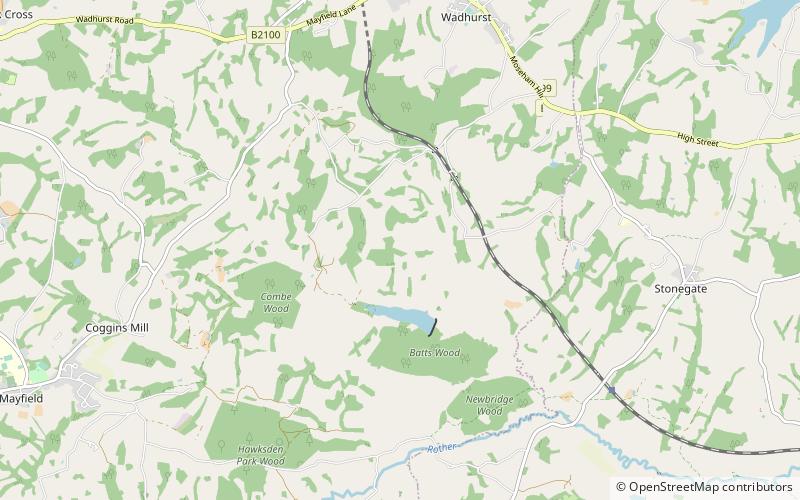Wadhurst Park, High Weald Area of Outstanding Natural Beauty
#16 among attractions in High Weald Area of Outstanding Natural Beauty

Facts and practical information
Wadhurst Park is a landed estate located in Wadhurst, East Sussex. It is owned by the Rausing family. ()
High Weald Area of Outstanding Natural Beauty United Kingdom
Wadhurst Park – popular in the area (distance from the attraction)
Nearby attractions include: Bateman's, Scotney Castle, Bowles, Bedgebury National Pinetum.
 Historical place, History museum, Museum
Historical place, History museum, MuseumBateman's, Burwash
98 min walk • Nestled in the heart of the East Sussex countryside, Bateman's is a charming 17th-century house that once served as the home of the famous writer Rudyard Kipling. Located in the quaint village of Burwash, the Jacobean building is constructed from the local sandstone...
 Forts and castles, History museum, Museum
Forts and castles, History museum, MuseumScotney Castle, Tunbridge Wells
136 min walk • Nestled in the serene countryside of Tunbridge Wells, Scotney Castle presents a picturesque vision of England's storied past. This quintessential castle, surrounded by a moat and set within a beautifully landscaped estate, dates back to the 14th century.
 Climbing, Game and entertainment center
Climbing, Game and entertainment centerBowles
159 min walk • Nestled in the serene countryside of the United Kingdom, Bowles presents an exceptional climbing spot that caters to enthusiasts and professionals alike. This outdoor adventure hub is renowned for its high-quality sandstone cliffs, offering a variety of routes that...
 Park
ParkBedgebury National Pinetum
156 min walk • Bedgebury National Pinetum at Bedgebury, Kent, in the United Kingdom, is a recreational and conservational arboretum managed by Forestry England that was established as the National Conifer Collection in 1925 and is now recognised as the most complete collection of conifers on one site anywhere in the world.
 Monastery, Ruins
Monastery, RuinsBayham Old Abbey
125 min walk • Bayham Old Abbey is an English Heritage property, located near Lamberhurst, Kent, England. Founded c. 1207 through a combination of the failing Premonstratensian monasteries of Otham and Brockley, Bayham functioned as an abbey until its dissolution in the 16th century.
 Museum
MuseumFinchcocks
162 min walk • Finchcocks is an early Georgian manor house in Goudhurst, Kent. For 45 years it housed a large, visitor-friendly museum of historical keyboard instruments, displaying a collection of harpsichords, clavichords, fortepianos, square pianos, organs and other musical instruments.
 Forest
ForestCombwell Wood, High Weald Area of Outstanding Natural Beauty
145 min walk • Combwell Wood is a 110.6-hectare biological Site of Special Scientific Interest south-east of Tunbridge Wells in Kent. The wood is part of the High Weald Area of Outstanding Natural Beauty. It is divided into 36 sections owned by different people.
 Gothic Revival architecture
Gothic Revival architectureWadhurst Castle, Wadhurst
51 min walk • Wadhurst Castle is a 19th-century castellated mansion just to the west of the town of Wadhurst, East Sussex, England, in an elevated position overlooking the countryside to the south. It is a grade II listed building.
 Forest
ForestWeald, Burwash
102 min walk • The Weald is an area of South East England between the parallel chalk escarpments of the North and the South Downs. It crosses the counties of Hampshire, Surrey, Sussex and Kent.
 Park
ParkBewl Water, Tunbridge Wells
94 min walk • Bewl Water is a reservoir in the valley of the River Bewl, straddling the boundary between Kent and East Sussex in England. It is about 2 miles south of Lamberhurst, Kent. The reservoir was part of a project to increase supplies of water in the area. It supplies Southern Water’s customers in the Medway towns, Thanet and Hastings.
 Church, Gothic architecture
Church, Gothic architectureChurch of St Dunstan
79 min walk • St Dunstan's, Mayfield in Mayfield, East Sussex was founded in 960 CE by St Dunstan, who was then Archbishop of Canterbury. It is reported as being originally a log church which lasted until it was replaced by a stone structure in the 12th century by the Normans.